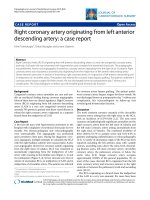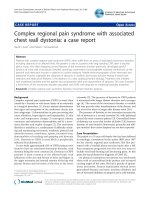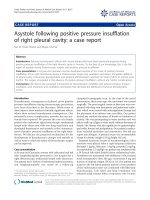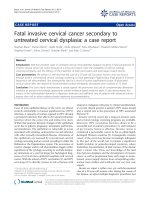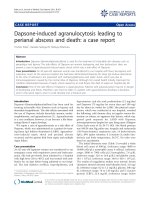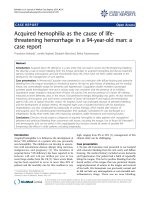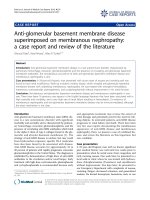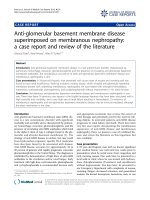Báo cáo y học: "Acquired hemophilia as the cause of lifethreatening hemorrhage in a 94-year-old man: a case report" pot
Bạn đang xem bản rút gọn của tài liệu. Xem và tải ngay bản đầy đủ của tài liệu tại đây (504.83 KB, 4 trang )
CAS E REP O R T Open Access
Acquired hemophilia as the cause of life-
threatening hemorrhage in a 94-year-old man: a
case report
Theodoros Kelesidis
*
, Jonelle Raphael, Elizabeth Blanchard, Rekha Parameswaran
Abstract
Introduction: Acquired factor VIII deficiency is a rare entity that can lead to severe and life-threatening bleeding.
We describe a case of severe bleeding from the tongue secondary to acquired hemophilia and discuss treatment
options, including aminocaproic acid and recombinant factor VIII, which have not been widely reported in the
literature for the management of such patients.
Case presentation: A 94-year-old Caucasian man presented to our institution with diffuse bruising and extensive
bleeding from the tongue secondary to mechanical trauma. He had no prior history of bleeding and his medical
history was unremarkable except for dementia and hypertension. Coagulation studies revealed a prolonged
activated partial thromboplastin time and a mixing study was consistent with the presence of an inhibitor.
Quantitative assays revealed a reduced level of factor VIII activity (1%) and the presence of a factor VIII inhibitor,
measured at seven Bethesda units, in the serum. Oral prednisone therapy (60mg/day) was given. He also received
intravenous aminocaproic acid and human concentrate of factor VIII (Humate-P) and topical anti-thrombolytic
agents (1 00 units of topical thrombin cream). His hospital course was prolonged because of persistent bleeding
and the development of profuse melena. He required eight units of packed red blood cells for transfusion.
Hospitalization was also complicated by bradycardia of unclear etiology, which started after infusion of
aminocaproic acid. His activated partial thromboplastin time gradually normalized. He was discharged to a
rehabilitation facility three weeks later with improving symptoms, stable hematocrit and resolving bruises.
Conclusions: Clinicians should suspect a diagnosis of acquired hemophilia in older patients with unexplained
persistent and profound bleeding from uncommon soft tissues, including the tongue. Use of factor VIII (Humate-P)
and aminocaproic acid can be useful in this coagulopathy but clinicians should be aware of possible life-
threatening side effects in older patients, including bradycardia.
Introduction
Acquired hemophilia A is defined as the development of
factor VIII inhibitors in a patient who was previously
non-hemophilic. The inhibitors can develop in associ a-
tion with autoimmune disease, allergic drug reactions,
malignancies, and pregnancy [1]. The incidence of
acquired factor VIII deficiency has been reported to be
between 1.48 and 1.34 per million per year in two
recent large studies from the UK [1]. Since severe bleed-
ing has been reported to occur in more than 85% of
patients and the mortality rate for this condition is very
high, ranging from 8% to 22% [1], management of this
clinical entity can be challenging.
Case presentation
A 94-year-old Caucasian man presented to our hospital
with extensive bleeding from his oral cavity and diffuse
bruising. His medical hist ory included severe d ementia
and hypertension. Our patien t had a habit of repeatedly
biting his tongue. This led to pr ofuse bleeding from the
dorsal surface of his tongue that was persistent despite
surgical placement of sutures in the tongue and removal
of his teeth. His hemostasis was p reviously normal and
he did not take any anticoagulants or non-steroidal anti-
inflammatory drugs. There was no nose bleeding,
* Correspondence:
Department of Medicine, Caritas St Elizabeth’s Medical Center, Tufts
University School of Medicine, Boston, MA, USA
Kelesidis et al. Journal of Medical Case Reports 2010, 4:231
/>JOURNAL OF MEDICAL
CASE REPORTS
© 2010 Kelesidis et al; licensee BioMed Central Ltd. This is an Open Access article distributed under the terms of the Creative
Commons Attribution License ( which permits unrestricted use, distribution, and
reproduction in any medium, provided the original work is properly cited.
hematuria, bloody stool or accompanying hemoptysis.
Our patient did not have any family history of bleeding
disorders. On examination, his vital signs were stable
and he was afebrile. There was profuse bleeding from
the tongue with the presence of multiple clots in the
oral cavity. No other bruising or active bleeding was
noticed, except extensive bruising over his upper extre-
mities and the presence of a hematoma on the left hand
with active oozing. Laboratory tests revealed a white
blood cell count of 9500 cells/μLwithaninitialhemo-
globin l evel of 11.7 g/dL and a platelet coun t of 149 ×
10
3
cells/ μL. Coagulation studies revealed a normal pro-
thrombi n time and international normalized ratio, and a
prolonged activated partial thromboplastin time of 73
seconds (n ormal: 24.8 to 36.1 seconds). The presence o f
an inhibitor of coagulation was diagnosed via prolong ed
activated partial thromboplastin time and a mixing
study that did not correct with the addition of normal
plasma (partial thrombo plastin time (PTT) 36.4 seconds
when an immediate mixing test was performed, with a
ratio of patient’ s plasma to normal plasma of 1:1)
(Figure 1). Quantitative assays revealed a reduced level
of factor VIII activity (1%) and the presence of factor
VIII inhibitor measured at 7 Bethesda units (BU) in the
serum.
Our patient was not intubated for airway protection
based on the wishes of his family. In total, two units of
fresh frozen plasma and eight units of packed red blood
cells were transfused and three doses (100 U/kg) of
recombinant human factor VIII (Humate-P 29 58 RCO)
were given to our patient as initial management.
Humate-P was chosen based on the lack of an alterna-
tive bypass agent such as recombinant activated FVII
(rFVIIa) in the setting of acute severe bleeding. Oral
prednisone therapy (60 mg/day) was given, and he also
received two doses of intravenous aminocaproic acid
(3 g intravenously over 1 h our followed by an infusion
of 750 mg/hour for 8 hours) and topical anti-
Figure 1 Results of mixing study using different ratios of patient’s plasma or normal plasma at different time points (0, 0.5, 1 and
2 hours). Partial thromboplastin time (PTT) is expressed in seconds.
Kelesidis et al. Journal of Medical Case Reports 2010, 4:231
/>Page 2 of 4
thrombolytic agents (topical thrombin cream 100 units
was used once) because of ongoing and active bleeding.
His hospital course was also complicated by complete
heart block, which developed immediately after the infu-
sion of the seco nd dose of intravenous aminocaproic
acid. Of note, our patient was initially admitted with a
heart rate of 80 beats/minute and he had a first-degree
AV block and left anterior fascicular block on his admis-
sion electrocardiogram. Our patient was not a candidate
for a transvenous pacemaker secondary to his severe
coagulopathy. He required use of vasopressors initiall y,
but he subsequently remained hemodynamically stable
with a heart rate of 30 beats/minute. He deve loped pro-
fuse melena for two weeks, most likely as a consequence
of swallowing the blood coming from his tongue. His
activated partial thromboplastin time (aPTT) gradually
improved (38.4 seconds). Our patient’s family refused
further diagnostic in vestigation in terms of finding an
underlying cause for the acquired hemophilia such as
malignancy. He was discharged to a rehabilitation facil-
ity with improving symptoms, stable hemoglobin (9 g/
dL) and minimize d bruises after three weeks o f hospita-
lization. A repeat test for the level of factor VIII inhibi-
tor in serum four weeks after our patient was on
steroids showed a reduction to 1BU while VIII activity
had also increased (10%). Our patient was discharged on
40 mg of predn isone as immunosuppre ssive therapy
with a treatment plan for a slow tapering of steroids as
well as careful monitoring of his coagulation parameters.
On follow-up six weeks af ter discharge, his bradycardia
had reversed and his heart rate had increased to 85
beats/minute, which suggests that the initial b radycardia
was likely related to the infusion of aminocaproic acid.
Discussion
Acquired inhibitors against factor VIII, also termed
acquired hemophilia A, occurs rarely, with an incidence of
approximately 1 to 4 per million/year. Although uncom-
mon, this condition is associated with a high rate of mor-
bidity and mortality as severe bleeding occurs in up to
90% of a ffected patients [1]. For these reasons, patients
with acquired hemophilia A represent a clinical challenge.
The etiology of acquired hemophilia A remains
unclear . In approximately half of cases, factor VIII auto-
antibodies occur in patients without any identifiable
cause, while the remaining cases may be associated with
autoimmune diseases, infections, use of medications in
the pos t-partum period, or underlying hematological or
solid tumors [1]. The diagnosis can be difficult to make
and bleeding tends to occur in soft tissue, the retroperi-
toneal space, and the gastrointestinal and genitourinary
tracts [1].
Treatment should be focused on controlling the
immediate bleeding episode and suppressing the
immune reaction ag ainst the coagulant factor. Immuno-
suppressive therapy with ster oids (1 mg/kg /day orally
for four to six weeks according to rece nt guidelines) or
cyclophosphamide for inhibitor eradication should begin
immediately after diagnosis is made [1,2].
Several different medications are available to c ontrol
bleeding. Anti-fibrinolytics are increasingly being used
to limit blood loss in major surgical procedures and in
patients with mucosal bleeding [3]. More specifically,
epsi lon aminocaproic acid counteracts fibrinolytic activ -
ity by reversibly blocking lysine binding sites on plasmi-
nogen molecules [3] and has been used mostly in
patients undergoing cardiac surgery and orthotropic
liver transplantation [3]. Aminocaproic acid is generally
well tolerated but adverse events include gastrointestinal
reactions, headache, ede ma, bradycardia, hypotension,
thrombosis and rhabdomyolysis [3]. Although aminoca-
proic acid has been used extensively in congenital
hemophilia [4], we describe only the sixth cas e of use of
aminocaproic acid in a setting of acquired hemophilia
[4-8]. We found only one other case in the literature of
severe bradycardia that developed in the setting of
severe bleeding from acquired factor VIII inhibitor, but
the authors did not address whether this bradycardia
was associated with the infusion of aminocaproic acid
[5]. However, immediately after the second infusion of
aminocaproic acid our patient developed complete heart
block and became hypotensive. However, the contribu-
tion of an underlying conduction abnormality cannot be
exclud ed. Placement of a pacemaker was not attempted
since this has been associated with severe complications
in the setting of acquired factor VIII inhibitors [5].
In patients who have developed antibodies to factor
VIII, a number of options are available. In patients with
higher titers of inhibitor, activated factor VII can be
used [2]. Recombinant activated coagulation FVII
(rFVIIa) has recently been licensed for use in acquired
hemophilia in the US [2]. By directly activating FX on
the surface of activated platelets at the site of injury
(thereby bypassing FVIII and FIX), rFVIIa can circum-
vent the act ions of inhibitory antibodies present in
patients with acquired hemophilia [2]. Human FVIII
concentrates usually represent an inadequate hemostatic
therapy unless the inhibitor titer is low (that is, less
than 5BU) [2]. Plasma-derived or recombinant human
FVIII concentrates can be used in patients with low-titer
inhibitors, which should be administered at doses suffi-
cient to overwhelm the inhibitor and thus achieve
hemostatic levels of factor VIII [2]. Hemostasis can
usually be achieved if plasma levels are ra ised from 30%
to 50% [9,10]. Although Humate-P has been used exten-
sively for treatment of von Willebrand disease, experi-
ence with its use in factor VIII in hibitor remains very
limited [9,10]. Acco rding to recent recommendations,
Kelesidis et al. Journal of Medical Case Reports 2010, 4:231
/>Page 3 of 4
human plasma-derived or recombinant FVIII concen-
trates can be used in acquired hemophilia for the treat-
ment of minor bleeding manifestations and acute
bleeding episodes when the inhibitor titer is low ( ≤
5BU) [2], and no bypassing age nt is immediately avail-
able, as was the case with our patient. Autoantibodies
can be very difficult to saturate with factor VIII concen-
trate due to the variability of inhibitor pharmacokinetics.
Although there are no prospective, randomized, con-
trolled clinical st udies to assess th e dosing of factor VIII
concentrate in the setting of acquired hemophilia,
according to previ ous studies, a bolus loading dose of
factor concentrate (usually 20 to 50 IU/kg) can be used
to neutralize the inhibitor, and for maintenance subse-
quent doses of factor concentrate can be g iven either by
bolus (20 to 50 IU/kg every 6 to 8 hours) or by continu-
ous infusion (3 to 4 IU/kg/hour) [2]. The Bethesda assay
was not immediately available in our case and the lack
of another bypass agent in the setting of severe bleeding
from the upper airways led us to the decision to admin-
ister recombinant factor VIII. We used a relatively high
Humate-P dose, and three boluses (100 IU/kg) were
given 12 hours apart with adequate hemostasis and pro-
gressive control of the bleeding from the tongue. Thus,
ourcaseaddstotheclinicalexperienceofuseof
Humate-P in cases of acquired factor VIII deficiency.
The dosage of FVIII concentrate should be adjusted
depending on plasma FVIII levels and bleeding symp-
toms [2]. Another interesting finding in our case was
the p resence of persistent melena for two weeks in the
setting of persistent bleeding from the tongue secondary
to acquired factor VIII inhibitor. While bleeding from
soft tissues and mucosal surfaces has been described in
the setting of this coagulopathy, such profound life-
threatening bleeding from the tongue has not been
described previously, to our knowledge. Our patient
responded well to immunosuppression with corticoster-
oids, and he will remain on tapering doses of corticos-
teroids with monitoring of factor VIII activity and factor
VIII inhibitor levels.
Conclusions
In conclusion, acquired hemophilia A is an extremely
rare clinical entity. E xperience with concomitant admin-
istration of anti-fibrinolytics and rFVIIIa treatment in
patients with this entity is limited. Use of Humate-P can
be useful in this coagulopathy, whereas use of aminoca-
proic a cid in states of acquired hemophilia may some-
times be associated with life-threatening complications
including bradycardia. Diagnosis of acquired hemophilia
requires clinical acumen, and clinicians should suspect a
diagnosis of a cquired hemophilia in patients with unex-
plained persistent and profound bleeding from soft tis-
sue and mucosa and i n any patient who presents with
bleeding and a prolonged activated pa rtial thromboplas-
tin time without other cause.
Consent
Written informed consent was obtained from the
patient’s next of kin for publication of this case report
and any accompanying images. A copy of the written
consent is available for review b y the Editor-in-Chief of
this journal.
Authors’ contributions
TK analyzed and interpreted the patient data and was a major contributor in
writing the manuscript. JR analyzed the patient data and contributed in
writing the manuscript. RP and BE analyzed and interpreted the patient data
and were major contributors in writing the manuscript. All authors read and
approved the final manuscript.
Competing interests
The authors declare that they have no competing interests.
Received: 9 November 2009 Accepted: 29 July 2010
Published: 29 July 2010
References
1. Franchini M, Lippi G: Acquired factor VIII inhibitors. Blood 2008,
112:250-255.
2. Huth-Kühne A, Baudo F, Collins P, Ingerslev J, Kessler CM, Lévesque H,
Castellano ME, Shima M, St-Louis J: International recommendations on the
diagnosis and treatment of patients with acquired hemophilia A.
Haematologica 2009, 94:566-575.
3. Fraser IS, Porte RJ, Kouides PA, Lukes AS: A benefit-risk review of systemic
haemostatic agents: part 1: in major surgery. Drug Saf 2008, 31:217-230.
4. Sahu S, Raipancholia R, Pardiwalla FK, Pathare AV: Hemostasis in acquired
hemophilia–role of intracavitary instillation of EACA. J Postgrad Med 1996,
42:88-90.
5. Jy W, Gagliano-DeCesare T, Kett DH, Horstman LL, Jimenez JJ, Ruiz-Dayao Z,
Santos ES, Ahn YS: Life-threatening bleeding from refractory acquired
FVIII inhibitor successfully treated with rituximab. Acta Haematol 2003,
109:206-208.
6. Lalwani RB, Stricker RB: Case report: successful use of antifibrinolytic
therapy in acquired factor VIII deficiency. Am J Med Sci 1992, 303:398-401.
7. Dachman AF, Margolis H, Aboulafia E: Does Sjogren’ s syndrome
predispose surgical patients to acquired hemophilia? J Am Osteopath
Assoc 1995, 95:115-118.
8. Bern MM, Sahud M, Zhukov O, Qu K, Mitchell W Jr: Treatment of factor XI
inhibitor using recombinant activated factor VIIa. Haemophilia 2005,
11:20-25.
9. Schramm W: Haemate P von Willebrand factor/factor VIII concentrate: 25
years of clinical experience. Haemophilia 2008, 14(Suppl 5):3-10.
10. Berntorp E, Archey W, Auerswald G, Federici AB, Franchini M, Knaub S,
Kreuz W, Lethagen S, Mannucci PM, Pollmann H, Scharrer I, Hoots K: A
systematic overview of the first pasteurised VWF/FVIII medicinal product,
Haemate P/Humate -P: history and clinical performance. Eur J Haematol
Suppl 2008, 70:3-35.
doi:10.1186/1752-1947-4-231
Cite this article as: Kelesidis et al.: Acquired hemophilia as the cause of
life-threatening hemorrhage in a 94-year-old man: a case report. Journal
of Medical Case Reports 2010 4:231.
Kelesidis et al. Journal of Medical Case Reports 2010, 4:231
/>Page 4 of 4

